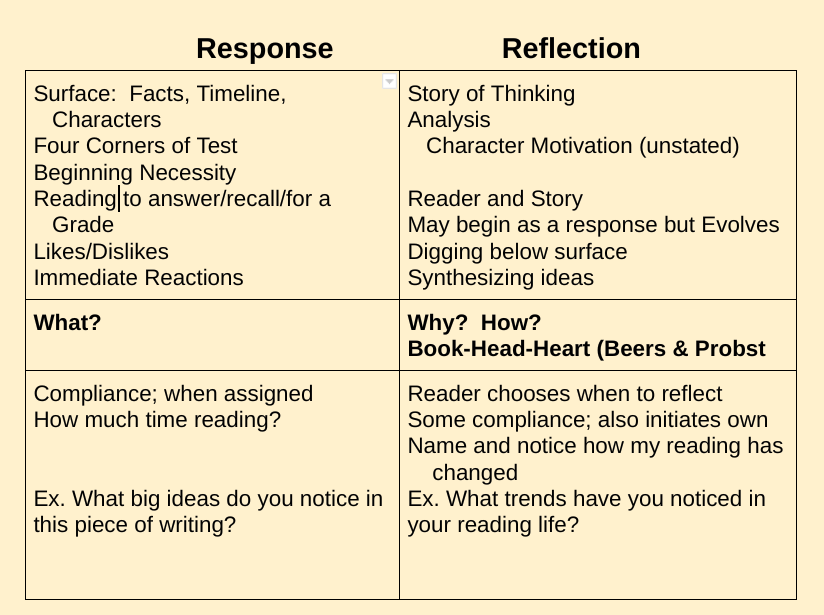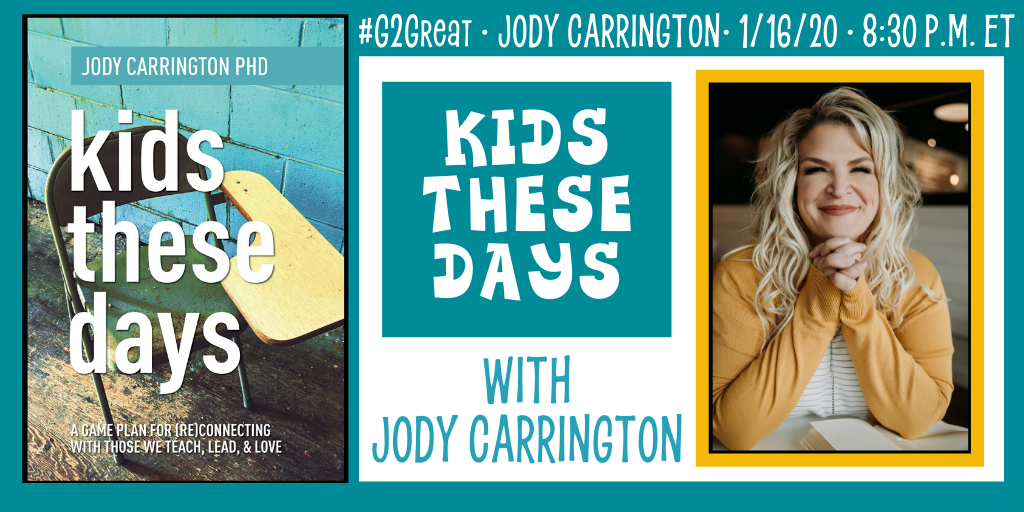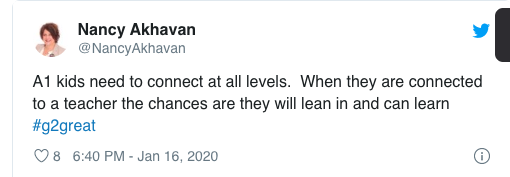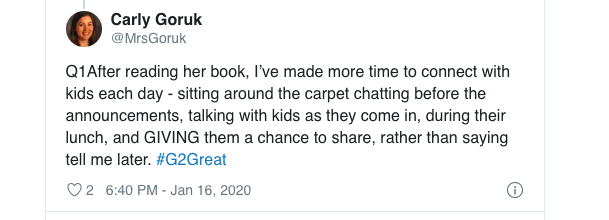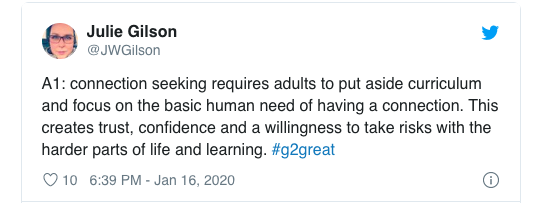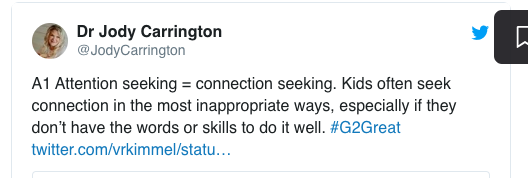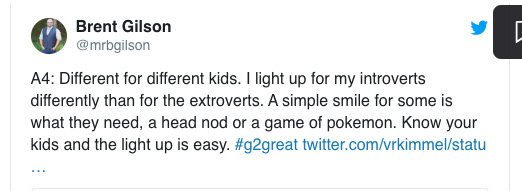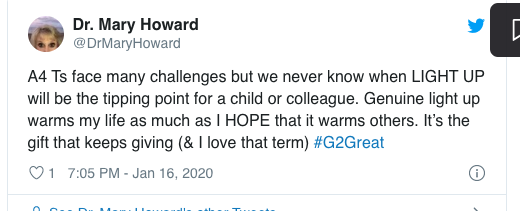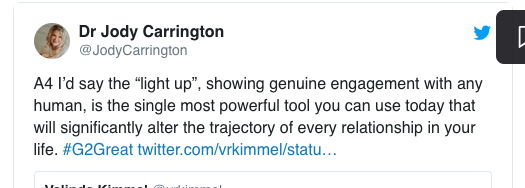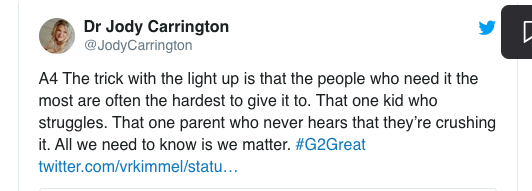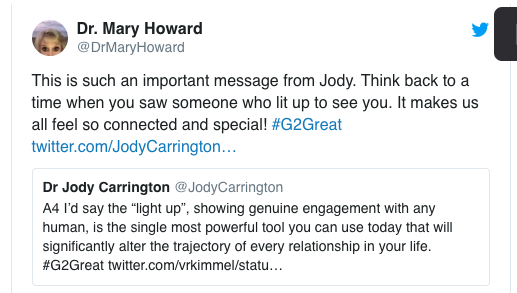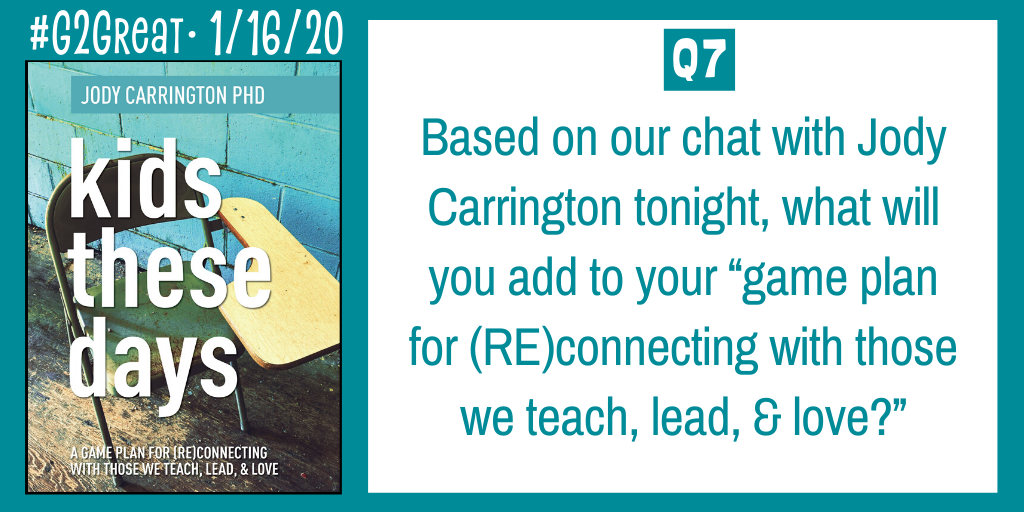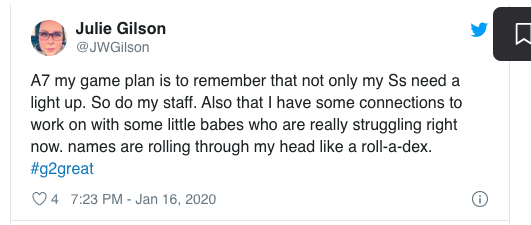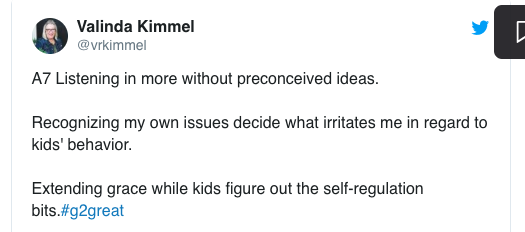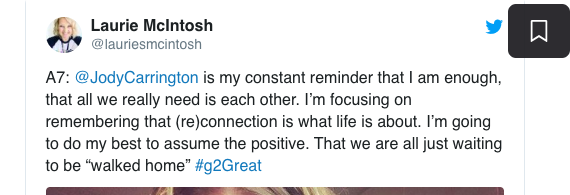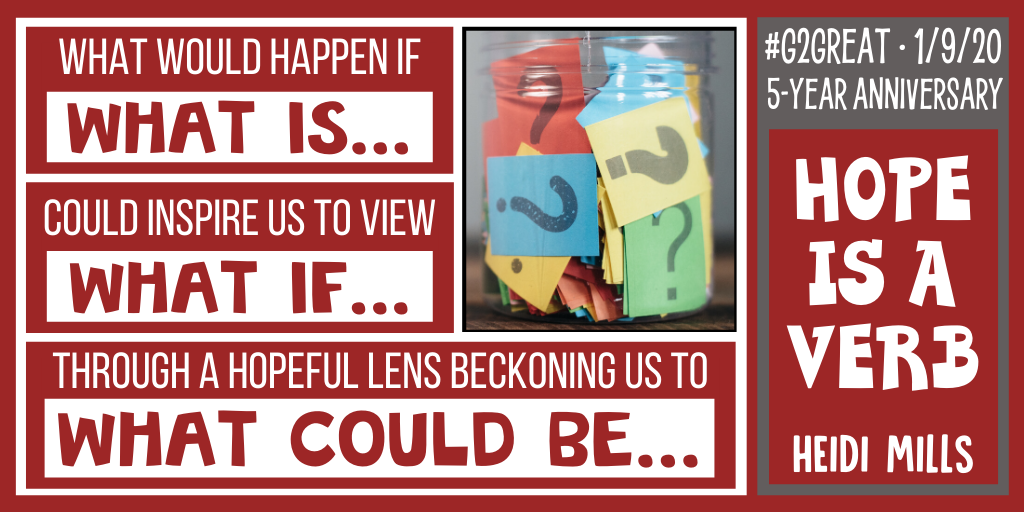By Fran McVeigh
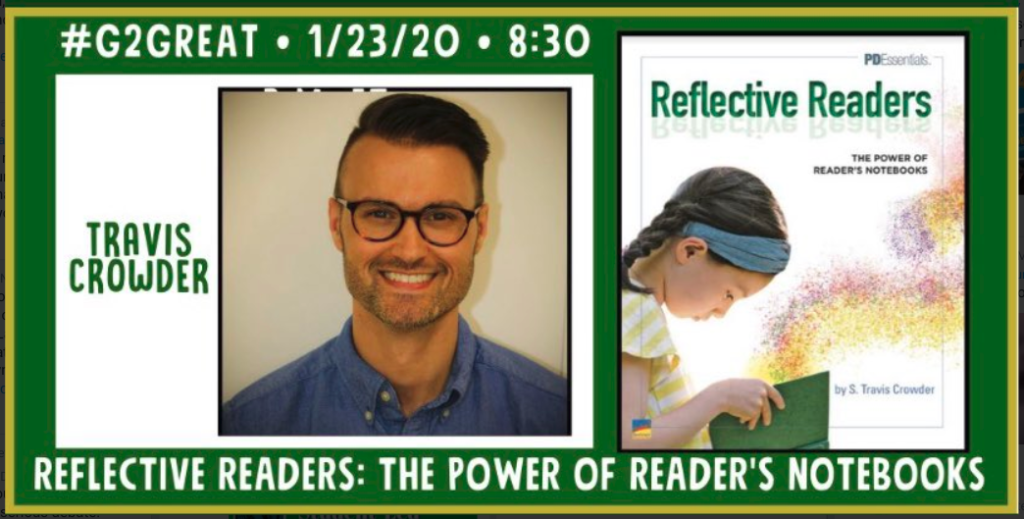
On Thursday, January 23, 2020, Travis Crowder shared his wisdom with the #G2Great community around his new book, Reflective Readers: The Power of Reader’s Notebooks. The Wakelet link above will yield hours of clarity, direction and awareness of reading selves which are at the center of reflection. Because being REFLECTIVE is the heart of this book, this post begins with Travis and his reflections.
What motivated you to write this book? What impact did you hope that it would have in the professional world?
Since I began teaching, reflective thinking has been at the heart of what I do with students. As my instructional practice moved from traditional to a workshop approach, I found myself asking students often to look back at their reading and their reading lives and write what they noticed— new understandings, beliefs, feelings, and the changes they saw in themselves as readers and thinkers. Without even recognizing it, these ideas became the foundation for action research I was doing in my classroom.
I wrote this book to share my thinking with colleagues who are intrigued by the critical literacy work we do, as well as educators who are wanting to see shifts in students’ reading lives. I stand on mighty shoulders. My work with readers is heavily influenced by other educators who have learned alongside their students. I hope that teachers will take my ideas and place them beside their own. I don’t see my work as a replacement of the work teachers are already doing, or a program; instead, it’s a model of thought, one that has helped me move my readers forward. It has deepened their thinking, helping them see how they’ve grown in their personal reading lives. I hope that it will help the professional world look at reflection differently, and hopefully, engage us in a discourse that will ultimately make our students grow into confident and more capable readers.
What are your BIG takeaways from your book that you hope teachers will embrace in their teaching practices?
First, it’s important to know that response and reflection are not synonymous. They serve different purposes in the life of a reader. Second, it’s important to have a balance of them in the classroom. When I started writing about reflection several years ago, I noticed a beautiful dance between response and reflection— the ebb and flow, how one naturally moves into the other. So often, writing about reading stops at response, and although responses to texts are paramount, reflective thinking is what moves kids into deeper analysis. Last, I want teachers to help students read better versions of themselves. We teach in a climate where kids have forgotten what it means to connect. But we can remind them of their sentience. With books and time to respond and reflect, we can help them see the models of the world that await them in stories. And over time, I truly believe they will impact their world.
So what did we explore during the chat? Three key items emerged as I perused the Wakelet and revisited my notes. Those items are: clarity, direction, and reading selves. You know your own practices best. Will you begin with reflective work in your own reader’s notebook or with the work your students are doing in their readers’ notebooks?
Clarity
The chat began as does Reflective Readers with a discussion of what “reflection” is and isn’t including its relationship to “response”. Both response and reflection can include personal thoughts but it really depends upon the depth of the work which can be readily accessed in a student’s writing in a reader’s notebook. This notion of similarities and differences between response and reflection led me to making a personal T chart to compare the two in order to help me both define and understand them. A response is often tied directly to the surface facts or elements of the story, character, or plot lines. A reflection usually reveals more thinking that connects the text and the reader. As I explored this idea for several days (remembering that I see the questions in advance), I considered my past experiences and opened up my own reader’s notebook. Response, response, response. That is what seemed to be expected in many classes and in work that requires text evidence. Multiple choice tasks. Tasks with “right” answers. . . Those all led to responses. Reflection came in when I spent time digging into a specific topic/theme and compared texts or how I personally connected texts in novel ways. How does clarity of REFLECTION help you to deepen your own understanding?
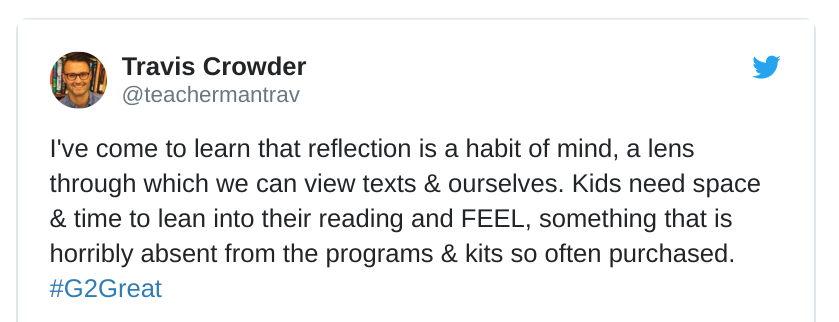
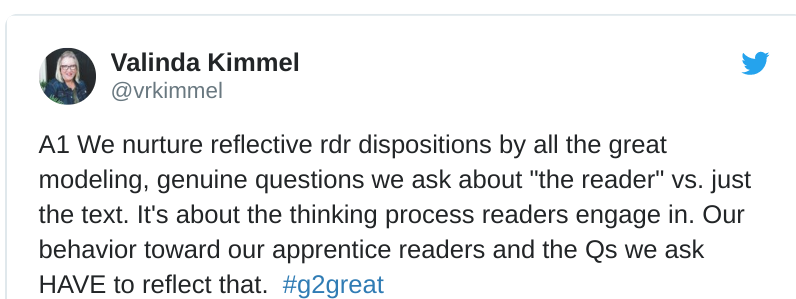


Direction
Where does our reflection lead us? The direction of our thoughts depends on our reading, our texts, the time and space that we provide for reflection, and our goals and values. Reflection cannot be rushed. Reflection provides “the contour to our experiences, and forms the geography of our thinking.” (Crowder, T. Reflective Readers. p. 6) Students can document their own growth and change in their reflections as Travis so beautifully shares the frames in his portrait gallery of students. Do you want to up the game for students? Frame their work. Provide frames or mats to showcase the importance.
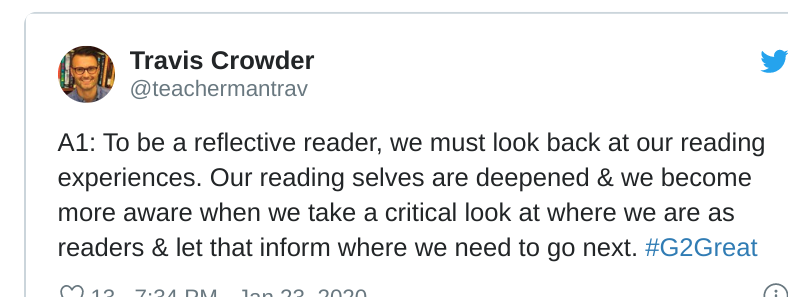
Reading Selves
What are the habits of readers? What are the most important habits of readers? Your values influence your answers. One inarguable habit would be that one needs to read and read a lot. Volume of reading matters. It may have a different effect at different stages in life, but reading is at the core of being a reader. But is reading a lot sufficient to be a reader? I would argue that it is NOT sufficient. Instead it is the reflective thinking that develops additional life-long reading habits.
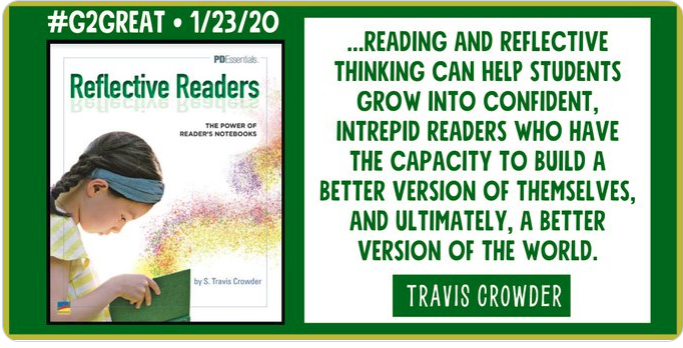
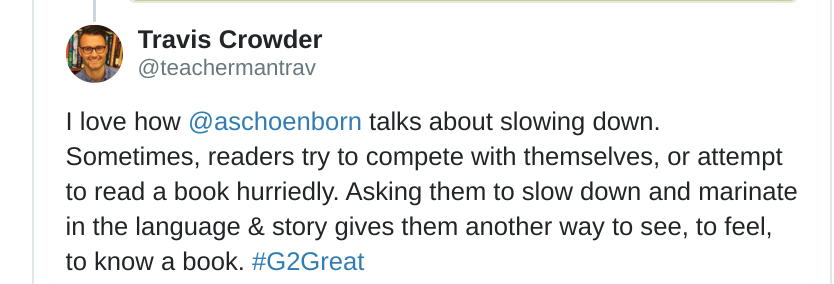

Just as we began with thoughts from Travis and myself, the conclusion will circle back to Travis’s message from the heart and my final thoughts about Reflective Readers.
What is a message from the heart you would like for every teacher to keep in mind?
The professional text that is at the center of this chat is a culmination of my thinking over the past several years. It is not a program or prescription for readers; instead, it’s a way of thinking about kids and their reading lives. More than anything, this book is the story of my literacy work with young people. I value the stories they bring to the classroom, the things that make them who they are, and I want them to see reflection as part of their story— of their reading and their learning. Giving students opportunities to respond and reflect with tools like hashtags and Tweets give them another lens through which to see their reading. They aren’t the only tools, though. I’m confident that the things that you do in your classroom to help your students tell the story of their learning are brilliant. Placing them beside my thinking will only strengthen what you’re already doing. And placing my thinking beside yours will nudge my readers, too.
Is reflection only for school days? I think not because I believe reflection is a lifetime pursuit. That is why this topic and text has fascinated me. I have to both respond and reflect on my own reading before I can ask students or teachers to do the same. Our own practice with responses and reflections will guide our learning journey as we develop our own portrait galleries. When we value competent, confident readers for today and tomorrow, our students will develop into the reflective readers that we need!
Additional resources:
Benchmark PD Essentials: Reflective Readers: The Power of Reader’s Notebooks (Link)
Travis Crowder Blog (Link)
Twitter: @teachermantrav
Fran’s T chart comparison of Response/Reflection . . . After Reflection
